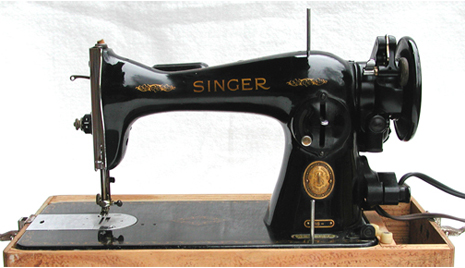
The data plate below the logo says Singer 15-. According to our limited research, the machine is a Singer Class 15-91. For a black machine of this era, it is unusual in that it has a direct drive. That is, the motor drives the machine through gears and not a belt drive. The motor can be seen in the image below.
While direct drive may eliminate the problem with loose or worn belts, it does pose other problems. The motor is lubricated by grease cups which we have been reluctant to address. The machine sounds different from belt driven machines and certainly has a more positive feel--when you depress the speed control petal, it goes without hesitation.
Its serial number is AL863228 indicating a manufactured date of 1954 in New Jersey. It uses Standard 15x1 needle. Bobbins are Singer Class 15. Feed dogs may be dropped by loosening a thumbscrew. Low shank.